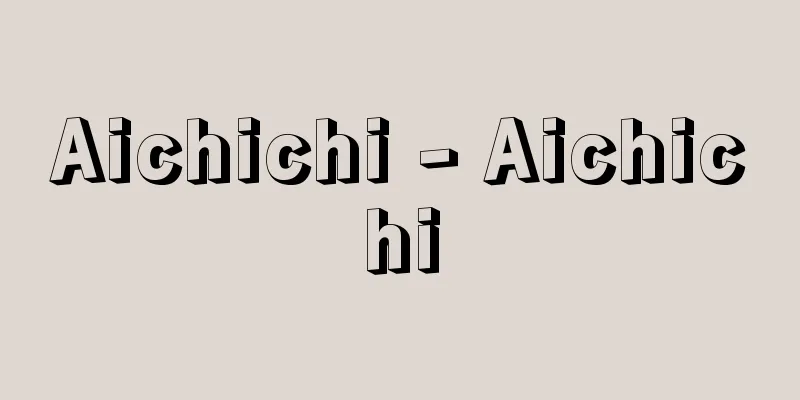Private collection - Butachu

|
It is a modern term, but it refers to an individual's collection of poems from before the early modern period. In the past, it was called ie no shu (family anthology) or shu (anthology), and was distinguished from uchigiki (collected poems) of poems by many people, such as senju (anthologies). Just as recorded diaries were called ie nikki (family diary) or kajo (family journal), family anthologies came from the consciousness of "family." The footnotes to the Manyoshu include the "Kakimoto no Asomi Hitomaro Kashu" and "Kasa no Asomi Kanamura Kashu," and individual collections of poems existed before the compilation of the Manyoshu. It is thought that these were compiled following the example of the "besshu" (personal collections of poems and prose) of poetry anthologies from the Six Dynasties period in China. The term "kashu" (family anthology) first appeared in the 9th century with anthologies of Chinese poetry and prose, such as "Denshi Kashu" and "Kanke no Shu." As for anthologies of poetry, from around the end of the 9th century, anthologies were compiled by imperial order (such as "Oe no Chisato Shu"), selected by the poet himself to be passed on to his descendants (such as the self-selected version of "Ki no Tsurayuki Shu"), selected by others for family members to carry on the poetic style of the deceased (such as "Yoritomo Ason Shu"), or compiled as social records of powerful families and imperial harems (such as "Mido Kanpaku Shu" and "Daisaiin Goshu"). Although there are cases where anthologies were selected by the poet himself or by others, they were originally called "kashu" because of the strong awareness of the family style behind the individual. As waka poetry began to spread socially from around the end of the 10th century, collections by famous poets were selected by others as models for verse, and many self-selected anthologies were also created based on creative desire. The literary awareness of waka poetry that began in the Insei period (late 11th century) led to the compilation of the Thirty-six Immortal Poets' anthologies, such as the Thirty-six Poets' Anthology, and the self-selection of a lifetime's best poems with the intention of making them public, such as the Sanboku Kikashu (Collection of Strange Poets). In the Kamakura period, great collections of poems were compiled, such as "Choshu Eiso" (Fujiwara Shunzei), "Sankashū" (Saigyo), "Shuigusō" (Fujiwara Teika), "Akishino Gesseishū" (Fujiwara Yoshitsune), "Minishū" (Fujiwara Ietaka), and "Shugyokushū" (Jien), which were called the "Rokukashū" (Six Collections of Poems). From then on, this mindset was passed down to the nobles' society of the early modern period, and they were compiled by themselves or by their family members. Because family anthologies are essentially private compilations, their direct purposes and forms vary widely, and they can take on a variety of forms, including those that are neatly categorized, those that are miscellaneous or chronological in form, those that are like diaries, and those that are compilations of a set number of poems. [Fumio Hashimoto] Source: Shogakukan Encyclopedia Nipponica About Encyclopedia Nipponica Information | Legend |
|
近代の術語であるが、近世以前の個人の歌集をいう。古く家集(いえのしゅう)または集(しゅう)とよばれ、撰集(せんじゅう)のような多人数による歌集の打聞(うちぎき)と区別される。家集とは、記録日記を家日記(いえにっき)、家乗(かじょう)と称したのと同じく、「家」の意識から出たものである。『万葉集』の左注に『柿本朝臣人麻呂歌集(かきのもとのあそみひとまろかしゅう)』『笠朝臣金村歌集(かさのあそみかなむらかしゅう)』などの記載があり、個人の歌集は『万葉集』編集以前に存在していた。これは中国六朝(りくちょう)時代の詩集の「別集」(個人の詩文集)に倣って編集されたものと思われる。「家集」の呼称は、『田氏家集(でんしかしゅう)』『菅家集(かんけのしゅう)』など9世紀の漢詩文の集に始まった。歌集としても、9世紀末ごろから、勅命によって自歌を集成(『大江千里集(おおえのちさとしゅう)』など)、子孫に伝えるため自撰(『紀貫之集(きのつらゆきしゅう)』自撰本など)、あるいは家族が故人の歌風を継承するため他撰(『頼基朝臣集(よりもとあそんしゅう)』など)、または権門(けんもん)・後宮(こうきゅう)の社交記録として編集(『御堂関白集(みどうかんぱくしゅう)』『大斎院御集(だいさいいんごしゅう)』など)したりした。このように自他撰の別はあるが、その始めは個人の背後に家風を強く意識したので、「家集」といわれた。 10世紀末ごろからの和歌の社会的な広まりとともに、著名歌人の集が詠歌の手本として他撰され、また創作的欲求に基づく多くの自撰家集も成立した。院政期(11世紀後半)に始まる和歌への文芸的自覚は、いわゆる三十六歌仙の家集を集めた『三十六人家集』などを編成させ、また『散木奇歌集(さんぼくきかしゅう)』(源俊頼(としより))のような公開を意図した生涯の秀歌撰を自撰させた。鎌倉時代に入り『長秋詠藻(ちょうしゅうえいそう)』(藤原俊成(しゅんぜい))、『山家集(さんかしゅう)』(西行)、『拾遺愚草(しゅういぐそう)』(藤原定家(ていか))、『秋篠(あきしの)月清集(げっせいしゅう)』(藤原良経(よしつね))、『壬二集(みにしゅう)』(藤原家隆(いえたか))、『拾玉集(しゅうぎょくしゅう)』(慈円)などの大家集が編集され、後世「六家集」と称された。以後、近世公家(くげ)社会までこの意識は受け継がれ、自らあるいは家人の手により編集された。 家集は本来的に私的な編纂(へんさん)物であるため、直接の目的、形態はさまざまであり、整然と部類されたもの、雑纂あるいは編年形態をとるもの、日記的なもの、定数歌を集成したものなど、その体裁はまちまちである。 [橋本不美男] 出典 小学館 日本大百科全書(ニッポニカ)日本大百科全書(ニッポニカ)について 情報 | 凡例 |
<<: Current cost basis; market price basis
>>: Shikajittetsu (English: Four Subjects and Ten Philosophies)
Recommend
Uffizi Gallery - Uffizi Museum (English name) Galleria degli Uffizi
An art museum in Florence, Italy. Its collection o...
Foreign Exchange Fund Special Account - GAIKOKU KAWASEISHINTOKUBETSU KAIKEI
A special account for managing the foreign exchang...
Tevye the Milkman
... The foundations of modern Yiddish literature ...
"The Golden Pastures and the Mountains of Jewels"
...The history of technology was therefore center...
Hirakata [city] - Hirakata
A city in northern Osaka Prefecture. It was incorp...
Knotting rope
A type of writing system that records things usin...
Wall Newspaper - kabeshinbun
A primitive form of newspaper that conveyed infor...
Quality of life
A way of thinking that emphasizes how rich a huma...
Kenya [Mountain] - Kenya
An extinct volcano located in central Kenya, East ...
Butterfly binding
It is pronounced "detchosou." It is a ty...
Bund of the evangelical churches in the DDR (English: Bundderevangelischen KircheninderDDR
…17 state churches are members. Eight state churc...
Yakuza movie - Yakuza movie
It is a general term for films with a yakuza as th...
Okatatsunamisou - Okatatsunamisou
A perennial plant of the Lamiaceae family (APG cl...
Semipalatinsk
A city on the east bank of the Irtysh River in Kaz...
Iguazu
(Iguazú Iguaçu) The world's largest waterfall ...









